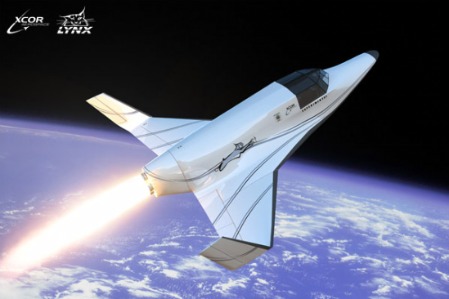XCOR was founded in 1999 and has grown from those four original founders, working out of a tiny hangar, to a team of two dozen highly skilled and talented employees housed in a 10,000 square foot hangar in Mojave, California. The employees of XCOR don’t just dream of affordable spaceflight, they are rapidly making it a reality. I had a chance this week to visit with one of them, company CEO Jeff Greason.
DarkSyde: It’s a beautiful, sleek looking vehicle in concept, but what good is a suborbital spaceplane aside from thrill rides?
Jeff Greason: Suborbital flight serves several purposes for XCOR’s business model, but I think it’s fair to say none of them could be accurately categorized as “thrill rides”. It provides a revenue stream from customers who wish to test all kinds of equipment beyond the time limits imposed by existing aircraft and well below the cost of traditional sounding rockets or orbital vehicles, and it allows us to test critical subsystems and devices that are being evaluated for ground to orbit boosters and orbiting spacecraft.
Because of the high altitude we can launch small rockets at incredibly low-cost with orbital payloads, and take direct readings and physical samples of the boundary between the mesophere and thermosphere — data that cannot be easily collected by even the highest flying research aircraft today. Now, if a researcher wants to test plant growth in microgravity, suborbital flight won’t do it. But a surprising number of important data points for tests and experiments, which up to now have had to be adapted for long duration flights at significant expense, can be reached much faster and way more cheaply in the quality microgravity environment the Lynx will deliver.
DS: What sets Lynx apart?
JG: We’re developing the world’s first suborbital spacecraft that takes off and lands on a runway, just like a commercial jet. This differs from competitors who are developing vehicles carried by large aircraft or which take off or land vertically. We settled on our design partly for reasons of safety and partly for practical reasons.
On re-entry for example, we precisely control the cross-section of wing presented to the surrounding air in the direction of motion. Thin air gets lots of wing, thicker air gets less. So the vehicle slows itself on descent, even the parts of Lynx taking the brunt of the re-entry never really get as hot as you might think. Our lead designers expect some portions of the vehicle might briefly exceed 500 degrees, but that’s in isolated spots and of course the vehicle is designed to deal with those kinds of stresses. Because of this traditional take off and controlled descent, passengers would only experience about 3 to 4 g-forces during the most dynamic portions of the flight. And our design will cost much less to operate, savings we can pass on to customers.
DS: Any news pertaining to XCOR since the Augustine report in 2009?
JG: Lots, we’re hard at work developing other systems beyond suborbital. Two stage ground to orbit vehicles and orbital spacecraft for example, and others which serve various part of the emerging commercial space market. Another important topic concerns future mission architecture, to the moon and beyond; do we place fuel depots in space or stick with the older methods used on Apollo? I believe the case for depots is strong, but that’s a topic for another day.
DS: Lastly, why do you think space is important to the nation or the world?
JG: Resources. I could on about this for a very long time, but in short there are vast quantities of materials and energy available in space — just the environment of microgravity and vacuum has enormous value to industry. The US space program has done us all a great service by showing what is possible and developing the technology that got us into space. Now, it’s up to companies like XCOR to build on that, to equip government and commercial ventures with the tools they’ll need to explore and deliver those resources back to earth where, as a nation and a species, we’re going to want them, and probably sooner rather than later!


That’s three rocket planes I’ve heard of:
– SpaceShip Two
– DarkSyde
– Dream Chaser
The only one of the three that I’m aware is already being developed as an orbital ship is Dream Chaser.